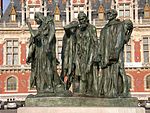Cité de la Dentelle et de la Mode

The Cité de la Dentelle et de la Mode is a museum of lace in Pas de Calais in northern France. It is one of two museums in France to celebrate machine lace making. The museum is an Anchor point on the European Route of Industrial Heritage. Cité de la Dentelle et de la Mode is a museum of both fashion and industry, its vast galleries present the techniques, the lingerie, and haute couture associated with this prestigious textile, as well as its most contemporary aspects. Derived from a technique invented in England in the nineteenth century, today lace woven on Leavers looms is primarily produced in Northern France. The Museum for Lace and Fashion is a focal hub for fashion. In its exhibition gallery, it showcases great couturiers and renowned young designers alike (Cristóbal Balenciaga, Anne Valérie Harsh, Iris Van Herpen, Hubert de Givenchy, On Aura Tout Vu, Yves Saint Laurent.)
Excerpt from the Wikipedia article Cité de la Dentelle et de la Mode (License: CC BY-SA 3.0, Authors, Images).Cité de la Dentelle et de la Mode
Rue de la Pomme d'Or, Calais
Geographical coordinates (GPS) Address Nearby Places Show on map
Geographical coordinates (GPS)
| Latitude | Longitude |
|---|---|
| N 50.9504 ° | E 1.8555 ° |
Address
Rue de la Pomme d'Or
62100 Calais
Hauts-de-France, France
Open on Google Maps











